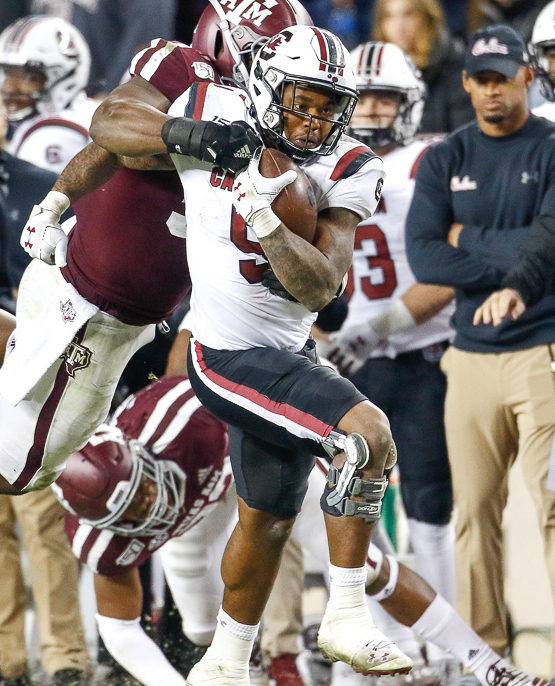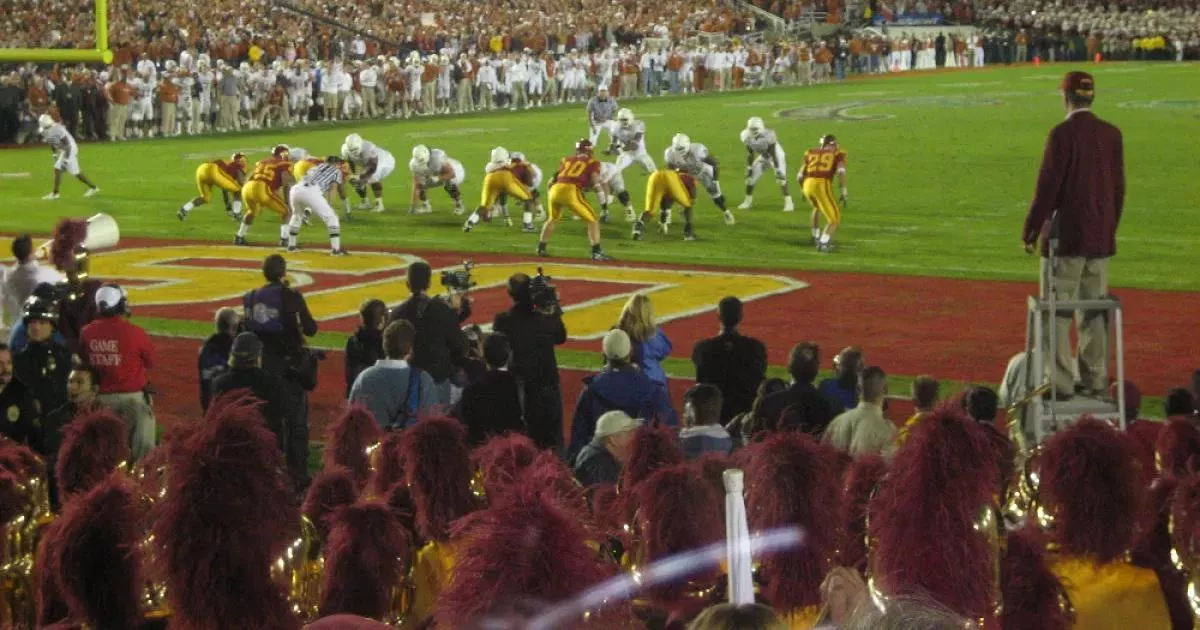Bowl games are postseason college football games in North America, primarily for NCAA Division I FBS teams. Historically, they served as de facto playoffs before formal systems like the Bowl Coalition, Bowl Alliance, BCS, and CFP were established. Prior to 2002, bowl game statistics were not included in players' career totals. Despite the evolution toward a structured national championship determination, some bowl games continue to be held, maintaining a tradition within college football.
1902: First Tournament East-West Football Game
In 1902, the first bowl game, the Tournament East-West football game, was sponsored by the Tournament of Roses Association, with Michigan defeating Stanford 49-0.
1916: Annual Tournament East-West Football Game
Starting in 1916, the Tournament of Roses began sponsoring an annual contest called the Tournament East-West Football Game.
1923: Rose Bowl Game
In 1923, the Tournament East-West Football Game began to be played at the newly completed Rose Bowl stadium, leading to the contest becoming known as the Rose Bowl Game.
1930: Only Major College Bowl Game
In 1930, the Rose Bowl was the only major college bowl game.
1935: Establishment of New Bowl Games
In 1935, the Sugar Bowl, Orange Bowl, and Sun Bowl were established.
1937: Cotton Bowl Classic
In 1937, the Cotton Bowl Classic was established.
1940: Five Major College Bowl Games
By 1940, there were five major college bowl games: the Rose Bowl, Sugar Bowl, Cotton Bowl Classic, Orange Bowl, and Sun Bowl.
1950: Eight Bowl Games
By 1950, the number of bowl games had increased to eight.
1951: Pro Bowl Instituted
In 1951, the NFL instituted the Pro Bowl as the name of its all-star game.
1952: Soccer Bowl
From 1950 to 1952, the United States men's college soccer championship was titled the 'Soccer Bowl'.
1960: Bert Bell Benefit Bowl Introduction
From 1960 to 1969, the NFL introduced the Bert Bell Benefit Bowl as a matchup of the two second-place teams in each division.
1960: Eight Bowl Games Persist
In 1960, the slate of eight bowl games persisted.
1968: Super Bowl Name Coined
The name "Super Bowl" was coined by Lamar Hunt in 1968 after watching his daughter play with a super ball.
1969: Bert Bell Benefit Bowl
From 1960 to 1969, the NFL used the Bert Bell Benefit Bowl as a matchup of the two second-place teams in each division.
1970: Eleven Bowl Games
By 1970, the number of bowl games had increased to 11.
1970: AFL-NFL Merger
When the professional football AFL–NFL merger occurred in 1970, the AFL–NFL World Championship Game became the NFL's championship and is now known as the Super Bowl.
1971: Number of Team-Competitive Bowls
In 1971, there were 10 team-competitive bowl games.
1973: Rose Bowl Attendance Record
The 1973 Rose Bowl set a Rose Bowl Stadium record and an NCAA bowl game attendance record with 106,869 attendees.
1975: Soccer Bowl
From 1975 to 1984, the North American Soccer League championship was titled the 'Soccer Bowl'.
1978: Division I-A Football Bowl Subdivision
From 1978 through 2005, the NCAA top level of football was known as Division I-A Football Bowl Subdivision.
1979: First German Bowl held
In 1979, the first German Bowl, the national championship game in American football in Germany, was held.
1980: First Vaahteramalja held
In 1980, the first Vaahteramalja, the national championship game in Finland, was held.
1980: Fifteen Bowl Games
In 1980, the number of bowl games had increased to 15.
1982: Florida State's Consecutive Bowl Appearances
Beginning in 1982, Florida State held the record of consecutive bowl berths at 36 bowl appearances from 1982 to 2017.
1984: Soccer Bowl
From 1975 to 1984, the North American Soccer League championship was titled the 'Soccer Bowl'.
1986: First Swiss Bowl held
In 1986, the first Swiss Bowl, the championship game of the Swiss Nationalliga A, was held.
1986: Eurobowl held annually
Since 1986, the Eurobowl, the final game of the European Football League, has been held annually.
1989: Football Bowl Association
An association of the bowl games themselves, independent of the NCAA, has existed since at least 1989 and was originally known as the Football Bowl Association.
1989: ECAC Bowl held
In 1989, the ECAC Bowl was held for Division I-AA teams.
1990: Nineteen Bowl Games
In 1990, the number of bowl games had increased to 19.
1992: Bowl Coalition Established
In 1992, the Bowl Coalition was established as an early attempt to create a permanent system to determine the FBS national champion on the field.
1992: Conference Agreements
Prior to 1992, most bowl games had strict agreements with certain conferences, which sometimes prevented the top-ranked teams from playing each other.
1994: Bowl Coalition
In 1994, the Bowl Coalition was in place as an attempt to create a permanent system to determine the FBS national champion on the field.
1995: Bowl Alliance Formation
In 1995, the Bowl Alliance was formed by major bowls and conferences to create a system where the two highest-ranked teams would play each other.
1997: Bowl Alliance
In 1997, the Bowl Alliance was in place as an attempt to create a permanent system to determine the FBS national champion on the field.
1998: Bowl Championship Series (BCS)
In 1998, the Bowl Championship Series (BCS) was in place as an attempt to create a permanent system to determine the FBS national champion on the field.
1999: First German Junior Flag Bowl
In 1999, the first German Junior Flag Bowl was held.
2000: German Flag Bowl and German Indoor Flag Bowl established
In 2000, the German Flag Bowl and German Indoor Flag Bowl were established in Germany.
2000: Twenty-Five Bowl Games
In 2000, the number of bowl games had increased to 25.
2001: NCAA Allows Teams with Losing Records to Participate in Bowls
Since the 2001 season, the NCAA sometimes allows teams with losing 5-6 and 5-7 records to participate in bowl games to fill slots.
2002: Bowl Game Statistics Change
Prior to 2002, bowl game statistics were not included in players' career totals.
2003: Split National Championship
In 2003, one-loss LSU won the BCS National Championship over Oklahoma, but the AP crowned one-loss USC champion after its Rose Bowl win.
2003: ECAC Bowl Held
In 2003, the ECAC Bowl was held for Division I-AA teams.
2005: Division I Football Bowl Subdivision (FBS)
From 1978 through 2005, the NCAA top level of football was known as Division I-A Football Bowl Subdivision.
2006: BCS Championship Game
In 2006, a dedicated BCS Championship Game rotated among the BCS venues.
2006: NCAA Vacates FSU's Emerald Bowl Victory
In 2006, the NCAA vacated Florida State's Emerald Bowl victory over UCLA due to an academic issue.
2007: North Atlantic Bowl held
In 2007, the North Atlantic Bowl was held, and it was later integrated into the conference's six-bowl series.
2008: Recent Development of NCAA Division III Bowls
At the NCAA Division III level, all bowls that are currently played are recent developments, starting in 2008 or later.
2008: Jerusalem Lions lift the Becker Trophy
In 2008, the Jerusalem Lions were the first to lift the Becker Trophy in the Israel Bowl.
2008: Prior bowl game events
Prior to 2008, the ECAC held the ECAC Bowl (1989–2003) for Division I-AA and the North Atlantic Bowl (2007).
2010: Bowl Game Participation
For the 2010 season, 70 of the 120 Division I FBS teams played in a bowl game.
2010: Thirty-Five Bowl Games
In 2010, the number of bowl games had increased to 35.
2013: Soccer Bowl
From 2013 to 2017, the North American Soccer League (II) championship was titled the 'Soccer Bowl'.
2013: Bowl Championship Series (BCS)
In 2013, the Bowl Championship Series (BCS) was in place as an attempt to create a permanent system to determine the FBS national champion on the field.
2014: College Football Playoff (CFP) Replaces BCS
For the 2014–15 season, the BCS was replaced by a new consortium, the College Football Playoff (CFP), a four-team single-elimination tournament.
2014: College Football Playoff (CFP)
In 2014, the College Football Playoff (CFP) was established as an attempt to create a permanent system to determine the FBS national champion on the field.
2015: Forty-One Bowl Games
By 2015, there were 41 bowl games, including the National Championship game.
2015: Citrus Bowl Reverts to Original Name
In 2015, the Capital One Bowl reverted to its original name, the Citrus Bowl, after some time.
2016: Bowl Season Length
For the 2016–17 bowl season, the 41 games required a little over three weeks, starting December 17 and ending on January 9.
2017: Bowl Game Locations
As of 2017, most bowl games (all but 5 of 41) are located in cities below approximately 36° N latitude, primarily in warm climates.
2017: End of Florida State's Consecutive Bowl Appearances
Florida State held the record of consecutive bowl berths at 36 bowl appearances from 1982 to 2017.
2017: NCAA Division III Bowls
For the 2017 season, 10 bowls were scheduled to be played by NCAA Division III teams that did not qualify for the playoffs.
2017: Soccer Bowl
From 2013 to 2017, the North American Soccer League (II) championship was titled the 'Soccer Bowl'.
2018: Alabama's Bowl Game Appearances
As of 2018, the University of Alabama has played in more bowl games than any other school, with 69 appearances, also holding the record for most bowl victories with 41.
October 2020: Rebranding as "Bowl Season"
In October 2020, the Football Bowl Association announced a rebranding as "Bowl Season".
2023: Growth in Number of Bowls
In 2023, the number of bowl games grew to 43, and more than a quarter of the teams participating did not have winning records.
2024: CFP Expansion
For the 2024–25 season, the CFP expanded to a 12-team format, with members of the New Year's Six now either hosting the quarter-finals and semi-finals on a rotating basis.
Mentioned in this timeline

College football is a popular amateur sport in the United...
Germany officially the Federal Republic of Germany is a Western...

The Super Bowl is the annual championship game of the...

Football is a family of team sports primarily involving kicking...
Florida a state in the Southeastern United States is largely...
Alabama is a state in the Southeastern United States bordered...
Trending

5 months ago Blue Angels Prepare to Soar Over Seattle for Seafair Weekend Festival Air Show

Rico Dowdle is an American professional football running back currently playing for the Carolina Panthers in the NFL He played...

7 months ago Ricky Pearsall sidelined from OTAs with hamstring injury; recovery and return uncertain.

2 months ago Jordan Love's wife, Ronika Stone, supports the Packers QB, balancing personal and professional life.

15 days ago Johnny Depp Describes His Life with Vanessa Paradis as 'Blissful' in Recent Statement.
6 months ago Denver Rattled: Rare 2.9 Magnitude Earthquake Shakes Colorado, Raising Questions About Seismic Activity
Popular

Candace Owens is an American conservative political commentator and author...

Ilhan Omar is an American politician currently serving as the...

XXXTentacion born Jahseh Dwayne Ricardo Onfroy was a controversial yet...

Tom Cotton is an American politician and Army veteran currently...

Kelsey Grammer is an accomplished American actor producer and singer...

Oprah Winfrey an American talk show host television producer actress...
